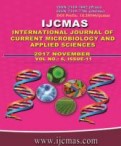


 National Academy of Agricultural Sciences (NAAS)
National Academy of Agricultural Sciences (NAAS)

|
PRINT ISSN : 2319-7692
Online ISSN : 2319-7706 Issues : 12 per year Publisher : Excellent Publishers Email : editorijcmas@gmail.com / submit@ijcmas.com Editor-in-chief: Dr.M.Prakash Index Copernicus ICV 2018: 95.39 NAAS RATING 2020: 5.38 |
The present study was conducted to determine and to compare the microbial population of ATM and computer keyboard within the University of Port Harcourt and also to determine the role of plasmid and resistance in Staphylococcus sp isolated from the high touch areas. A total of 70 swabbed samples was collected and cultured on different media and the organisms were identified using its colonial, morphological biochemical characteristics. The identified bacteria were subjected to antibiotic sensitivity test using the disc diffusion method. The plasmid of isolated S. aureus was cured by treatment with acridine orange. Results obtained from the study indicated that some of the ATM and the keyboards were positive for the presence of microorganisms which include Staphylococcus aureus, Streptococcus sp, Klebsiella sp, Escherichia coli, Pseudomonas sp and Micrococcus sp. The antibiogram study was carried out on the identified organisms and the result showed that majority of the bacteria were resistant to most of the standard antibiotics including cloxacillin, followed by augmentin, erythromycin, tetramycin, and streptomycin. Staphylococcus sp were subjected to plasmid profiling with the use of acridine orange to detect the role of plasmid in their resistance and its was observed that they were susceptible to chloramphenical (98%), Gentamycin (94%), cotrimoxazole (78%), streptomycin (60%), tetramycin (58%), augmentin (52%) and cloxacillin (40%) because some antibiotic markers in Staphylococcus isolates are plasmid mediated . Hand washing after ATM and computer usage should be adopted to avoid contamination.
 |
 |
 |
 |
 |